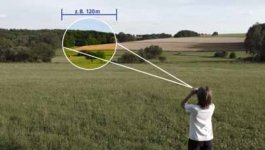The field of view describes the diameter of the circular view seen when looking through the optics. For example, if you look at the edge of a forest through binoculars at a distance of 1,000 m and see an area that is 120 m in diameter, the binoculars have a field of view of 120 m at 1,000 m.

The size of the field of view indicates how many metres wide on 1000m can be seen through the binoculars.
Occasionally, the viewing angle or objective viewing angle is given, e.g. 6°. The field of view and viewing angle can be easily calculated:
The field of view depends on the optical design of the binoculars but especially on the magnification, i.e. in general, lower magnification binoculars have a larger field of view than binoculars with higher magnification, although there are exceptions.
Very small fields of view can give the impression of looking through a tunnel. There is a lot of black on the outside and a small image area in the middle. This characteristic creates a rather unpleasant viewing experience which is best avoided.
Wide angle binoculars, on the other hand, deliver very large fields of view that not only provide a wide overview but also comfortable, pleasant observation.
If the field of view is so large that the image circle appears to have an angle of 60° or higher, then the binocular is considered to be a ‘wide- angle’ model according to the ISO norm/standard. This angle at which the image is observed in the eyepiece, is the subjective or ‘apparent’ viewing angle.
Is a field of view, e.g. 120 m at 1,000 m, good or bad for binoculars? The answer depends on the magnification. 10x binoculars with this field of view would be very good (subjective viewing angle approx. 69°), a 7x pair with this field of view would be rather weak (subjective viewing angle of 48° only). Notice how the subjective viewing angle shows immediately if the field of view is pleasantly large and comfortable, or if tunnel vision can be expected.
The field of view cannot be calculated from the simple format information (e.g. 10 x 42) but is determined by the optical design. The size of the prisms and the eyepiece determine the image angles that can pass through the binoculars. The objective lens diameter does not affect this and it only influences the brightness.
When comparing fields of view based on the linear measurement at 1,000 metres, remember that the view through the binoculars is a circle so only a modest increase in the diameter can be a significant one if you consider the area of the circle in square metres. For example, an increase of less than 10% in the linear measurement/diameter from 135 m to 148 m (a 9.6% increase) actually results in an increase in the area of view from 14,316 square metres to 17,201, an increase of 20%.
When comparing the edge definition of different binoculars, it is necessary to not only use the same format (e.g. 10 x 42) only, but also take the fields of view into consideration. If one pair has a field of view of 120 m and another only 100 m at 1,000 m, it is easier for the second to have better edge definition. However, this “benefit” comes with a considerable loss of field of view.
A wide field of view is very useful for many kinds of nature observation including scanning large areas of sky for hawks and eagles, or areas of water for whales and dolphins or re-surfacing diving birds such as ducks or divers (loons), and for capturing views of nearby fast-flying subjects such as warblers and butterflies or dragonflies.

The size of the field of view indicates how many metres wide on 1000m can be seen through the binoculars.
Occasionally, the viewing angle or objective viewing angle is given, e.g. 6°. The field of view and viewing angle can be easily calculated:
The field of view depends on the optical design of the binoculars but especially on the magnification, i.e. in general, lower magnification binoculars have a larger field of view than binoculars with higher magnification, although there are exceptions.
Very small fields of view can give the impression of looking through a tunnel. There is a lot of black on the outside and a small image area in the middle. This characteristic creates a rather unpleasant viewing experience which is best avoided.
Wide angle binoculars, on the other hand, deliver very large fields of view that not only provide a wide overview but also comfortable, pleasant observation.
If the field of view is so large that the image circle appears to have an angle of 60° or higher, then the binocular is considered to be a ‘wide- angle’ model according to the ISO norm/standard. This angle at which the image is observed in the eyepiece, is the subjective or ‘apparent’ viewing angle.
Is a field of view, e.g. 120 m at 1,000 m, good or bad for binoculars? The answer depends on the magnification. 10x binoculars with this field of view would be very good (subjective viewing angle approx. 69°), a 7x pair with this field of view would be rather weak (subjective viewing angle of 48° only). Notice how the subjective viewing angle shows immediately if the field of view is pleasantly large and comfortable, or if tunnel vision can be expected.
The field of view cannot be calculated from the simple format information (e.g. 10 x 42) but is determined by the optical design. The size of the prisms and the eyepiece determine the image angles that can pass through the binoculars. The objective lens diameter does not affect this and it only influences the brightness.
When comparing fields of view based on the linear measurement at 1,000 metres, remember that the view through the binoculars is a circle so only a modest increase in the diameter can be a significant one if you consider the area of the circle in square metres. For example, an increase of less than 10% in the linear measurement/diameter from 135 m to 148 m (a 9.6% increase) actually results in an increase in the area of view from 14,316 square metres to 17,201, an increase of 20%.
When comparing the edge definition of different binoculars, it is necessary to not only use the same format (e.g. 10 x 42) only, but also take the fields of view into consideration. If one pair has a field of view of 120 m and another only 100 m at 1,000 m, it is easier for the second to have better edge definition. However, this “benefit” comes with a considerable loss of field of view.
A wide field of view is very useful for many kinds of nature observation including scanning large areas of sky for hawks and eagles, or areas of water for whales and dolphins or re-surfacing diving birds such as ducks or divers (loons), and for capturing views of nearby fast-flying subjects such as warblers and butterflies or dragonflies.




